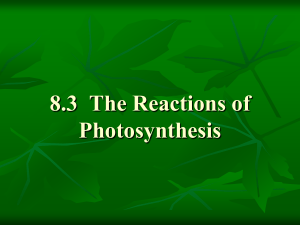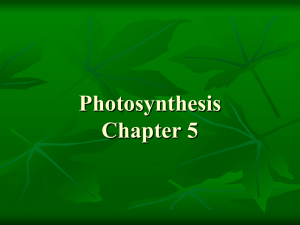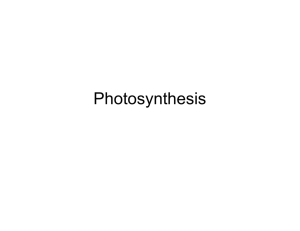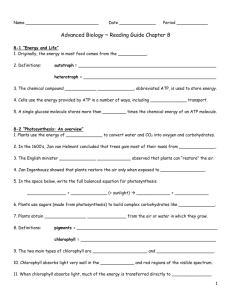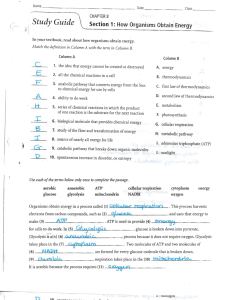Photosynthesis
advertisement
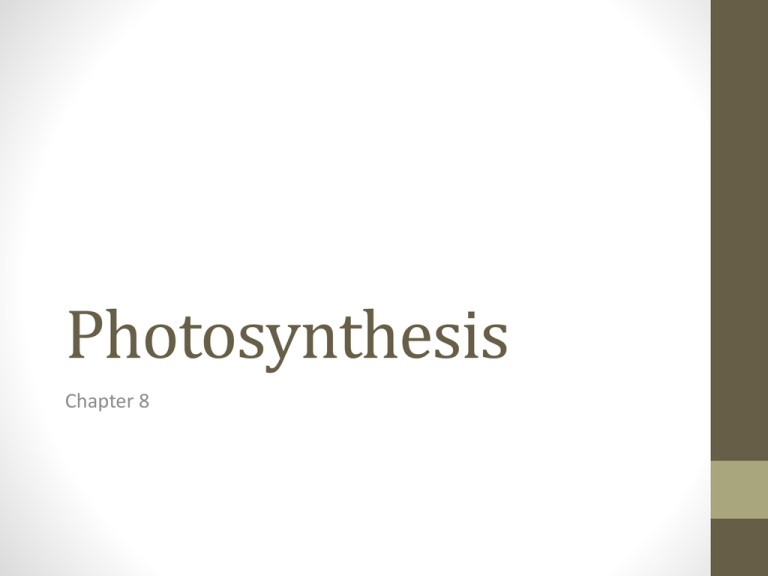
Photosynthesis Chapter 8 Energy and life • [1] __Energy___ is the ability to do work. Autotrophs • Plants and some other types of organisms are able to use light energy from the sun to produce food. Organisms such as plants, which make their own food, are called [2] __autotrophs_. Heterotrophs • Other organisms, such as animals, cannot use the sun's energy directly. These organisms, known as [3] __heterotrophs__, obtain energy from the foods they consume. Living things • To live, all organisms, including plants, must release the energy in sugars and other compounds. • Autotrophs use [4] _light__ energy from the sun to produce food. Chemical energy and ATP • Energy comes in many forms, including light, heat, and electricity. Energy can be stored in [5] _chemical ____ compounds ATP • Living things use chemical fuels as well. One of the principal chemical compounds that cells use to [6] __store___ and [7] _release__ energy is adenosine triphosphate, abbreviated ATP. • ATP consists of adenine, a 5-carbon sugar called ribose, and three phosphate groups. Those three phosphate groups are the key to ATP's ability to store and release energy ADP • Adenosine diphosphate (ADP) is a compound that looks almost like ATP, except that it has [9] __two___ phosphate groups instead of three. This difference is the key to the way in which living things store energy. ADP to ATP • When a cell has energy available, it can store small amounts of it by adding a [10] _phosphate__ group to ADP molecules, producing ATP, as shown in the figure at right. In a way, ATP is like a fully charged battery, ready to power the machinery of the cell. Release of energy • How is the energy that is stored in ATP released? Simply by [11] ___breaking__ the chemical bond between the second and third [12] _phosphate group__, energy is released Using biochemical energy • One way cells use the energy provided by ATP is to carry out [13] __active transport__. • Many cell membranes contain a sodiumpotassium pump, a membrane protein that pumps [14] _sodium ions__ (Na+) out of the cell and [15] __potassium__ (K+) into it. Protein synthesis • Energy from ATP powers other important events in the cell, including the [17] __synthesis_ of proteins and nucleic acids and responses to chemical signals at the cell surface. ATP storage • Most cells have only a [18] _limited__ amount of ATP, enough to last them for a few seconds of activity. • Even though ATP is a great molecule for transferring energy, it is not a good one for storing large amounts of energy over the long term. Glucose • A single molecule of the sugar[19] _Glucose__ stores more than 90 times the chemical energy of a molecule of ATP. • Therefore, it is more efficient for cells to keep only a small supply of ATP on hand. • Cells can [20] __regenerate_ ATP from ADP as needed by using the energy in foods like glucose. ATP from glucose 8.2 - Photosynthesis • The key cellular process identified with energy production is [21] __photosynthesis___. • In the process of photosynthesis, plants use the energy of sunlight to convert [22] __water___ and carbon dioxide into high-energy [23] ___carbohydrates____—sugars and starches—and [24] _oxygen_, a waste product. Photosynthesis • [25] __Photosynthesis__ uses the energy of sunlight to convert water and carbon dioxide into high-energy sugars and oxygen. • Plants then use the sugars to produce complex carbohydrates such as starches. • Plants obtain carbon dioxide from the air or water in which they grow. • Photosynthesis is a series of [26] __chemical reactions__ that uses light energy from the sun to convert water and carbon dioxide into sugars and oxygen. Photosynthesis equation • Although the equation tells you that [27] __water__ and • [28] ___carbon dioxide__ are required for photosynthesis, it does not tell you how plants use these low-energy raw materials to produce high-energy sugars. Light and pigment • In addition to water and carbon dioxide, photosynthesis requires light and [29] __chlorophyll__, a molecule in chloroplasts. • Plants gather the sun's energy with lightabsorbing molecules called [30] _pigments_. Chlorophyll • The plants' principal pigment is chlorophyll. • There are two main types of chlorophyll: chlorophyll a and chlorophyll b. • Chlorophyll [31] ___absorbs__ light very well in the blueviolet and red regions of the visible spectrum. Chlorophyll – light absorption • However, chlorophyll does not absorb light well in the green region of the spectrum. • Green light is reflected by leaves, which is why plants look green. Chlorophyll – light absorption • Plants also contain red and orange pigments such as carotene that absorb light in other regions of the spectrum. • Photosynthesis requires light and chlorophyll. • Because [32] ___light___ is a form of energy, any compound that absorbs light also absorbs the [33] __energy___ from that light. Chlorophyll – light absorption • When chlorophyll absorbs light, much of the energy is transferred directly to [34] _electrons_ in the chlorophyll molecule, raising the energy levels of these electrons. • These [35] _highenergy__ electrons make photosynthesis work. Van Helmont's Experiment • In the 1600s, the Belgian physician Jan van Helmont devised an experiment to find out if plants grew by taking material out of the soil. • Determined the mass of a pot of dry soil and a small seedling. • Planted the seedling in the pot of soil and watered it regularly. • At the end of five years, the seedling, which by then had grown into a small tree, had gained about 75 kg • The mass of the soil, however, was almost unchanged. He concluded that most of the gain in mass had come from water, because that was the only thing that he had added. Priestley's Experiment • English minister Joseph Priestley performed an experiment that would give another insight into the process of photosynthesis. • Priestley took a candle, placed a glass jar over it, and watched as the flame gradually died out. Something in the air, Priestley reasoned, was necessary to keep a candle flame burning. That substance was oxygen. • Priestley then found that if he placed a live sprig of mint under the jar and allowed a few days to pass, the candle could be relighted and would remain lighted for a while. • The mint plant had produced the substance required for burning. It released oxygen. Jan Ingenhousz • Dutch scientist Jan Ingenhousz showed that the effect observed by Priestley occurred only when the plant was exposed to light. • The results of both Priestley's and Ingenhousz's experiments showed that light is necessary for plants to produce oxygen. • The experiments performed by van Helmont, Priestley, and Ingenhousz led to work by other scientists who finally discovered that in the presence of light, plants transform carbon dioxide and water into carbohydrates, and they also release oxygen. 8-3 The Reactions of Photosynthesis • Inside a Chloroplast • photosynthesis takes place inside chloroplasts. • Chloroplast, contain saclike photosynthetic membranes called thylakoids (THY-luh-koydz). • Thylakoids are arranged in stacks known as grana (singular: granum). • Proteins in the thylakoid membrane organize chlorophyll and other pigments into clusters known as photosystems. • These photosystems are the light-collecting units of the chloroplast. Photosystem • The reactions of photosystems in two parts: • the light-dependent reactions [takes place in the thylakoid membranes] • the light-independent reactions, or Calvin cycle [takes place in the stroma] Electron Carriers • Sunlight excites electrons in chlorophyll, the electrons gain a great deal of energy. • Electron carriers are used to transport high-energy electrons from chlorophyll to other molecules. • A carrier molecule is a compound that can accept a pair of high-energy electrons and transfer them along with most of their energy to another molecule. • This process is called electron transport, and the electron carriers themselves are known as the electron transport chain Electron carriers Carrier molecule • One of these carrier molecules is a compound known as NADP+ (nicotinamide adenine dinucleotide phosphate). • NADP+ accepts and holds 2 high-energy electrons along with a hydrogen ion (H+). • This converts the NADP+ into NADPH. • The NADPH can then carry high-energy electrons produced by light absorption in chlorophyll to chemical reactions elsewhere in the cell. Light-Dependent Reactions • The light-dependent reactions use energy from light to produce ATP and NADPH. • The light-dependent reactions produce oxygen gas and convert ADP and NADP+ into the energy carriers ATP and NADPH. Light-dependent reactions • Photosynthesis begins when pigments in photosystem II absorb light. • That first photosystem is called photosystem II because it was discovered after photosystem I. • The light energy is absorbed by electrons, increasing their energy level. • These high-energy electrons are passed on to the electron transport chain. Light-dependent reactions • The thylakoid membrane contains a system that provides new electrons to chlorophyll to replace the ones it has lost. • These new electrons come from water molecules (H2O). • Enzymes on the inner surface of the thylakoid membrane break up each water molecule into 2 electrons, 2 H+ ions, and 1 oxygen atom. • The 2 electrons replace the highenergy electrons that chlorophyll has lost to the electron transport chain. • As plants remove electrons from water, oxygen is left behind and is released into the air. Light-dependent reactions • High-energy electrons move through the electron transport chain from photosystem II to photosystem I. • Energy from the electrons is used by the molecules in the electron transport chain to transport H+ ions from the stroma into the inner thylakoid space. Light-dependent reactions • Pigments in photosystem I use energy from light to reenergize the electrons. • NADP+ then picks up these high-energy electrons, along with H+ ions, at the outer surface of the thylakoid membrane, plus an H+ ion, and becomes NADPH. Light-dependent reactions • As electrons are passed from chlorophyll to NADP+, more hydrogen ions are pumped across the membrane. • After a while, the inside of the membrane fills up with positively charged hydrogen ions. • This makes the outside of the thylakoid membrane negatively charged and the inside positively charged. • The difference in charges across the membrane provides the energy to make ATP. • This is why the H+ ions are so important. Light-dependent reactions • H+ ions cannot cross the membrane directly. • However, the cell membrane contains a protein called ATP synthase (SIN-thays) that spans the membrane and allows H+ ions to pass through it. • As it rotates, ATP synthase binds ADP and a phosphate group together to produce ATP. • Because of this system, lightdependent electron transport produces not only highenergy electrons but ATP as well. Light-dependent reactions • The light-dependent reactions use water, ADP, and NADP+, and they produce oxygen and two high-energy compounds: ATP and NADPH. Calvin cycle • Six carbon dioxide molecules enter the cycle from the atmosphere. • The carbon dioxide molecules combine with six 5-carbon molecules. • The result is twelve 3-carbon molecules. Calvin cycle • The twelve 3-carbon molecules are then converted into higher-energy forms. • The energy for this conversion comes from ATP and highenergy electrons from NADPH. Calvin cycle • Two of the twelve 3carbon molecules are removed from the cycle. • The plant cell uses these molecules to produce sugars, lipids, amino acids, and other compounds needed for plant metabolism and growth. Calvin cycle • The remaining ten 3carbon molecules are converted back into six 5-carbon molecules. • These molecules combine with six new carbon dioxide molecules to begin the next cycle. Photosynthesis Photosynthesis - summary • Light-dependent reactions • Purpose – produce energy for the Calvin cycle • Reactant • H2O • Products • ATP • NADPH • O2 • Calvin cycle • Purpose – produce food for the plant • Reactant • CO2 • Products • High-energy sugars • Sucrose • Glucose • Fructose


